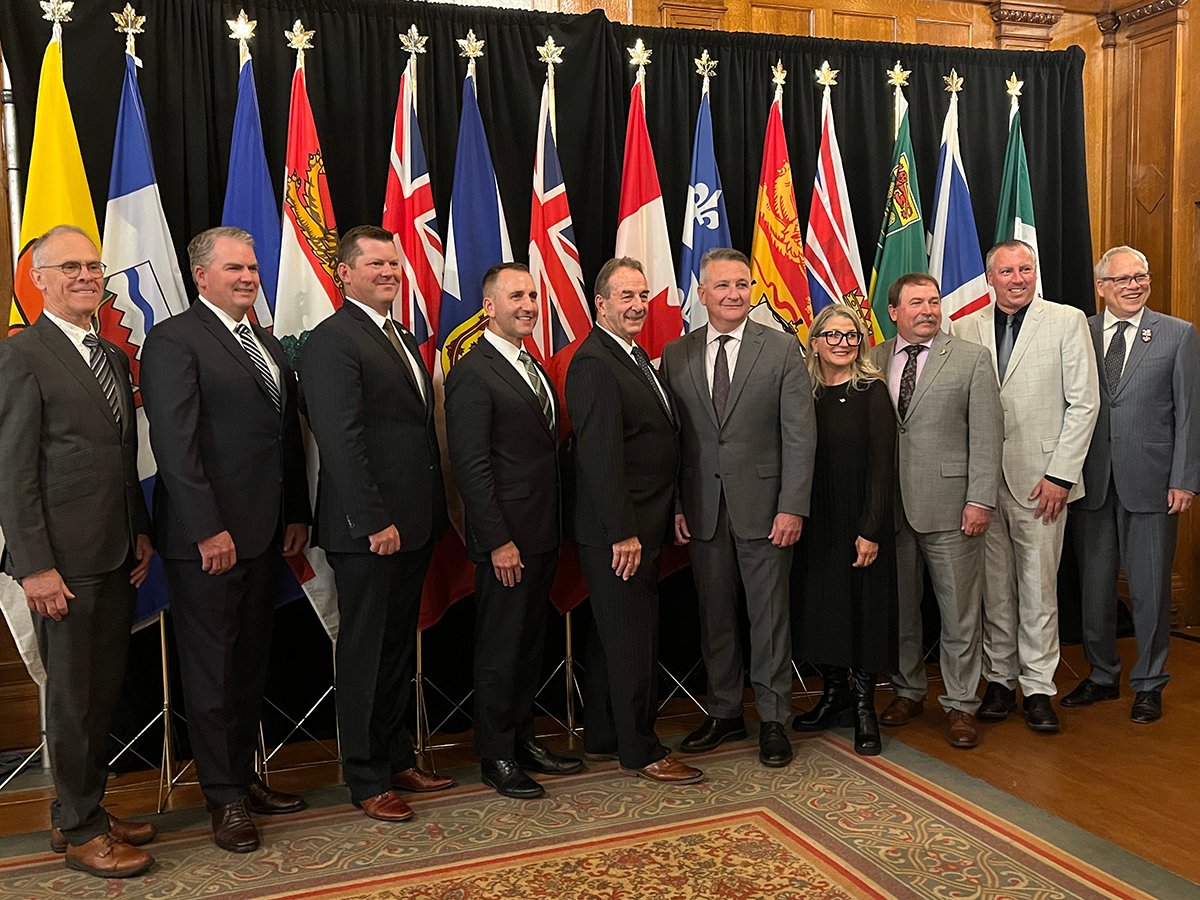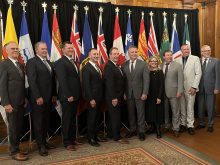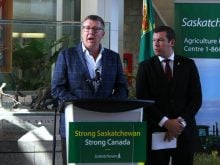WAINWRIGHT, Alta. – Alberta farmers may receive cheques within the week
for their share of the $324 million drought aid announced by the
provincial government July 17.
“This is our response to try and help producers deal with their most
urgent needs,” Alberta agriculture minister Shirley McClellan said
during a news conference in eastern Alberta to announce the Farm Income
Assistance Program.
“We can’t maybe mitigate all the effects of this drought, but through
this program we have tried to address some of the very urgent issues.”
Read Also

Ag ministers hear request for regulatory change, more infrastructure development
Canada’s agriculture ministers met today in Winnipeg after postponing their usual July in-person meeting due to wildfires.
She said farmers can make their own decisions how best to spend the aid
money on their farms.
Alberta farmers should start to receive money within 10 days of the
announcement, she added. Those who applied for acreage payments in 2001
only need to check a box on the application and sign the form if their
farm operation hasn’t changed.
Eighty-five percent of the money will be paid when the application is
received. The other 15 percent will be paid after the application is
checked.
The program deadline is Nov. 30.
The per acre payout is designed to get money to farmers fast, McClellan
said. The program will pay:
- $7.15 per acre for cultivated cropland.
- $10 per acre for tame forage.
- $4 per acre for fenced forage that is not cultivated.
- $4.50 per beehive.
- $100 per acre for perennial horticulture crops.
- Twenty cents per sq. foot for covered crops such as greenhouses and
mushrooms.
“We knew that when we did this it isn’t perfect, but we also heard from
producers they needed a fast response,” McClellan said. She
acknowledged that a per acre payout doesn’t direct the money to farmers
who need it most.
“Yes, there are some people that will get this that don’t need it as
badly,” she said to reporters. “Do you want to draw the lines?”
About 75 percent of the province’s farmland is suffering from some form
of drought and more than half of the province’s municipalities have
declared drought disasters.
Even farmers in southern Alberta who received rain earlier in the year
are hurting from the same continuous hot, dry weather plaguing much of
the Prairies. Farmers with irrigation face higher watering costs.
“I can’t make it rain,” McClellan said. “If I could, I can assure you
it would have rained some time ago.”
Lloyd Andruchow, head of Alberta Agriculture’s program policy and
evaluation department, said there are no final numbers on how much the
drought will affect cropland.
Already there have been 10,000 insurance claims. More than 350
adjusters in northeastern Alberta are busy writing off crops.
Last year the province paid a record $280 million in crop insurance
claims. This year they expect that amount to be between $300 million
and $400 million.
Bob Barss, reeve of the Municipal District of Wainwright, estimates
that prolonged drought has hurt 95 to 100 percent of the crops in his
municipality.
Crop insurance adjusters have written off 350 acres of his canola and
he’s waiting for them to come back and write off the rest of his crop.
“I doubt if a combine will turn a wheel in the M.D. of Wainwright this
year.”
Barss also estimated that 80 percent of the 195,000 head of cattle in
the area have been sold already.
“It’s devastating. There’s no amount of money that will fix this
problem. You can’t feed a cow dollars.”
Rusty Stalwick of Nilsson Bros. Livestock Exchange in Vermilion, Alta.,
said the money won’t save the cattle herds in his area.
“Big deal. That money doesn’t save the pasture and it ain’t going to
keep the cows over winter.”
Peter Wynnychuk of Vermilion said the government waited too long to
announce the aid program.
“There’s some farmers that need the money to buy feed right now,” said
Wynnychuk, while watching a cattle sale in Vermilion.
“It’s bad for the grain farmer, but it’s worse for the cattle. They’ve
got to be looked after.”
McClellan said that when the cattle sales are finished, about one-third
of the province’s 2.2 million head cow herd will have gone to slaughter
or to another province.
Bryce Motley of Czar, Alta., said he won’t complain about the amount of
money he receives.
“It’s better than nothing,” said Motley, who will pay bills with his
portion, but is not sure if it will be enough to save his cattle herd.
Motley just returned from two days in Saskatchewan trying to find
pasture for his remaining 100 heifers. He already sold half his animals
to take the pressure off his pasture.
“I’m trying to hang onto the rest of them for dear life.”
He now has to figure out if keeping the best 100 heifers from a herd
he’s spent 30 years building makes economic sense, or if he’s just
delaying the inevitable.
He estimated it will cost $50 a cow to ship them to the pasture he
found near Yorkton, Sask., another $1.25 to $1.50 a head per day to
feed them, and $50 each to bring them home.
Grant Hicks, president of the Alberta Beekeepers Association, said
including beekeepers in the program is recognition that they are an
important part of agriculture. Two years ago beekeepers were left out
of a payout program and lobbied hard to be included.
In 2000 beekeepers were paid $3 per hive and last year $4 per hive.
This program gives them $4.50 a hive. It’s well short of the
$120-per-hive operating costs, but a good industry boost, he said.
“It’s one more tool in our emergency kit,” he said. “I don’t want to
quibble about dollar amounts.”
He estimated honey production will be about half of normal this year.
Alberta New Democrat MLA Brian Mason said the program’s big winners
will be corporate farms, not family farms. The government has put a cap
of $100,000 per farmer and a $500,000 cap for corporations.
“Why do corporations rate five times better than family farms? The
government got it backwards.”
He said the government should be promoting smaller farming operations
instead of propping up large agricultural corporations.
McClellan said the program will spend new money, not the $110 million
already committed by the province as part of a federal and provincial
bridging program,until a long-term farm program is established.














